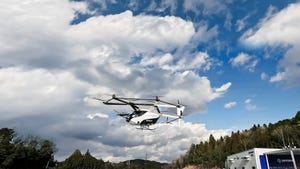Smart Farming: Where Dirt Meets DataSmart Farming: Where Dirt Meets Data
Guest commentary by John Deere's Kevin Seidl on how today's farmers use data to make informed decisions
.png?width=1280&auto=webp&quality=95&format=jpg&disable=upscale)
When most people think about farming, they likely only think about working in the dirt. But for farmers, the complexities of farming go far beyond that. On average, farmers put in 12-18 hours a day of work to grow food for all of us. They take note of where each seed is planted, how machines are operating and how the weather conditions are impacting their crop. And this can’t occur without technology. You can call the soil a farmer’s office, and with a range of technology from GPS to artificial intelligence (AI), machine learning (ML) to edge computing, it’s one of the most technologically advanced workplaces around.
Subscribe to the IoT World Today Newsletter
With the world population expected to reach 10 billion by 2050, farmers will need to produce 50% more food, making technology even more important. But the population increase is only one of the challenges facing farmers. They need to produce more food while also dealing with extreme variability across their land, complicated and time-sensitive decision making, and a decreasing labor pool.
To keep their business going and provide for us all, a farmer must wear many hats: farmer, entrepreneur. mechanic, meteorologist, technologist. There’s one constant tying each of these roles together: data.
Data-Enabled Decision Making on the Farm
Farmers not only feed and fuel the world but also protect their land. Data helps inform all the decisions they make — whether understanding how much crop their fields have produced over time or if their machines are performing at their peak. But that data can only help if it’s captured and analyzed consistently and strategically. This requires farmers to also work as excellent record keepers. Often generations of the same family have worked the same land for decades. To keep the harvest prosperous, they’ve kept data on the performance of their fields. What was first gathered by hand in a notebook transitioned into spreadsheets. Fast forward to today: machines gather data, document it, and store it in the cloud. Then, often with the help of trusted third-party advisors, a farmer can analyze the data to help simplify complex decisions.
This data includes the number of seeds planted, yield of their crops, machine health and weather conditions, to name a few. That data is used for real-time decision making in the moment and also informs strategic decisions for years to come.
Collecting and Analyzing the Right Data
Advanced technology is key to the entire data collection process and includes a combination of elements such as sensors, the Internet of Things (IoT), AI, ML, and advanced robotics. This technology works alongside a highly accurate GPS system, which has helped guide machines through the field for more than two decades.
To paint a picture, every time a sprayer passes through the field, it collects data from sensors. The data comes in the form of images from cameras mounted on the sprayer’s boom and these images help defeat a farm’s bully — weeds. With computer vision and machine learning, a sprayer detects the location of every weed in a field. Once the system identifies a weed and calculates its position — as well as determining the speed of the sprayer and the location of the nozzles — herbicide lands only on the weed. Oh, and the sprayer does all this while moving across the field at 12 mph. All of this data is captured for the farmer to review and understand what changes they should make during their next operation.
By incorporating more advanced technology in the field, farmers are able to address:
Machine-to-machine communication: Wireless and data technologies enable machines to “talk” to one another. For example, two planters working in a field can talk to each other so each knows where the other has already planted, keeping them from duplicating efforts.
Precision through IoT: On-machine connectivity between a GPS network and assigned IoT functions, such as a sprayer nozzle or row unit, enable large machines to function with increasing precision. The average planter which has 24 rows, or electrified robots, is in charge of planting seeds over the course of a field. As the planter goes through the field, it leverages connectivity and sensors to measure a number of factors as seeds are placed one by one into the ground. Access to connectivity enables the transfer of data from the planter to the farmer to tend to any changes needed.
Communication through the cloud: Farmers today can monitor and manage their operations remotely in real-time through a mobile device thanks to the cloud. With access to real-time data, they can see how their machines are performing in the field and potential inefficiencies that need to be remedied. Data on things like the performance of the planter is also tracked via sensors. For instance, a farmer might notice that changes in soil conditions are causing seeds to be placed at the wrong depth. The farmer can then make adjustments in real-time to get them back where they should be.
The agriculture industry is a true example of how data-driven decision-making affects every person in the world — because we all need to eat. The future of farming is one where all machines can work together, using data to help produce more food for our growing population.
Read more about:
Smart FarmingAbout the Author
You May Also Like








